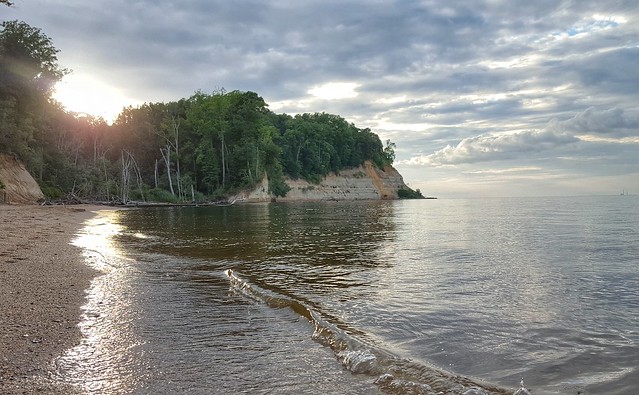Read Our Blogs
6 ways to spend Earth Day
Earth Day is an opportunity to give back to Mother Earth. There are so many ways to do this that it can feel overwhelming to attempt to give back what nature provides to us. I'm happy to help by giving you six ways you can make a big impact this Earth Day. Virginia State Parks are hosting Earth Day events between April 19-26, 2025, across the commonwealth to make it even easier for you to give back.
1. Plant natives for nature

A monarch butterfly on native butterfly milkweed in Kiptopeke State Park’s Native Plant Garden
Say thank you to pollinators this Earth Day by planting native, pollinator-friendly plants. Native species are those that naturally occur in the region in which they evolved. Since plants evolve over time, native plants possess certain traits that make them uniquely adapted to local conditions and provide the best resources to wildlife.
The following parks are hosting planting or native plant hiking events:
- Rejuvenating Occoneechee's Gardens - Occoneechee State Park
- Native Wildflower Field Tour (hike + craft) - New River Trail State Park
- Preserve the Beauty (gardening/planting) - Kiptopeke State Park
- Wonders of Native Wildflowers (hike + native plant giveaway) - Shenandoah River State Park
- Garden Clean up - Natural Tunnel State Park
- Wildflower Walk - Green Pastures Recreation Area (satellite location of Douthat State Park)
- Seed Bomb Slingshots (planting) - Hungry Mother State Park
- Seed Pod Planting - Wilderness Road State Park
2. Remove invasive plants
Invasive plants are species that have been introduced to our environment, are out of place and cause harm to our biodiversity. Invasive plants often crowd out or even kill native plants. Removing invasive species helps native flora and fauna to thrive with their native habitat.

Removing invasive plants at Staunton River Battlefield State Park
Learn which plants are invasive at Virginia State Parks by attending a removal event, such as the following.
- Help Battle Invasive Plants - Powhatan State Park
- Invasive Plant Removal - Douthat State Park
- Earth Day Service Project - Sky Meadows State Park
- Invasive Plant Removal - Fairy Stone State Park
3. Clean up a trail

A successful cleanup at James River State Park
Virginia State Parks depend on volunteers to help us maintain our 700+ miles of trails. Enjoy a hike and feel good about making the trail look better than how you found it by going to one of the following events.
- High Country Cleanup - Grayson Highlands State Park
- Litter Pickup - Twin Lakes State Park
- Trail Cleanup - Hungry Mother State Park
- Stewardship Saturday - Earth Day Cleanup - Natural Bridge State Park
- Earth Day Cleanup & Bird Survey - High Bridge Trail State Park
- Litter Leader (Who can pick-up the most litter?) - Lake Anna State Park
4. Clean up a beach or waterway
Help improve water quality by removing trash from beaches, creeks, lakes, etc. Trash in natural waterways doesn’t only look bad, it can harm wildlife and pollute our drinking water.
- Beach Cleanup - Chippokes State Park
- Clean Up Holliday Lake - Holliday Lake State Park
- Trash to Art Contest (clean up & then upcycling competition) - Caledon State Park
- Lake Cleanup - Hungry Mother State Park
- Trash Cleanup - Leesylvania State Park
- Shoreline Cleanup - Claytor Lake State Park

Fossil Beach at Westmoreland State Park. Photo by Bob Diller
5. Participate in community science
Community science (aka citizen science or participatory science) is simply observing nature and logging it publicly to share what you find. An example of community science is counting birds you see in an environment and logging what you spot in eBird — an online database of bird observations. This data provides scientists, researchers and naturalists with real-time information on bird migration and population.

Birdwatching at Claytor Lake State Park
Engage in community science by participating in a City Nature Challenge at New River Trail State Park. Or BioDiscovery at Hungry Mother State Park which gives you the chance to count flora and fauna species through a plant and animal scavenger hunt.
Other events include walks and talks about native ecology, below.
- Birding Hike - Lake Anna State Park
- Forage and Foster: Earth Day Ecology Hike - Sailor's Creek Battlefield State Park
- Fungus Among Us - Hungry Mother State Park
- Bike Meet-up: “Silverbell Ride” - Hiwassee to Draper - New River Trail State Park
- Basic Tree ID Walk - Green Pastures Recreation Area (satellite location of Douthat State Park, learn about this place here)
- Wild Plants of SWVA Walk - Hiwassee - New River Trail State Park
- Celebrate Earth Week - First Landing State Park
- Bird Counts on the new Ivanhoe Birding Trail - New River Trail State Park
6. Recycle and upcycle
Make a difference this Earth Day by donating your plastics. Learning about recycling and upcycling at workshops at various parks.
- Earth Day Upcycling - Paint Your Own Vase - Staunton River State Park
- Earth Day Power - Bear Creek LakeLake State Park
- Easter Egg Bird Feeders - Natural Tunnel State Park
- Crafting Hour - Twin Lakes State Park
Thank you for looking for ways to help our environment this Earth Day! We hope Virginia State Parks inspires you to take care of the world around you every day.
If you have read the article and have a question, please email nancy.heltman@dcr.virginia.gov.
Search for blogs
By Park
Categories
Cabins
Camping
Fishing
History and Culture
Other
Programs and Events
Trails
Volunteers
Water Fun
Archive
2025
2024
2023
2022
2021
2020
2019
2018
2017
2016
2015
2014
2012













